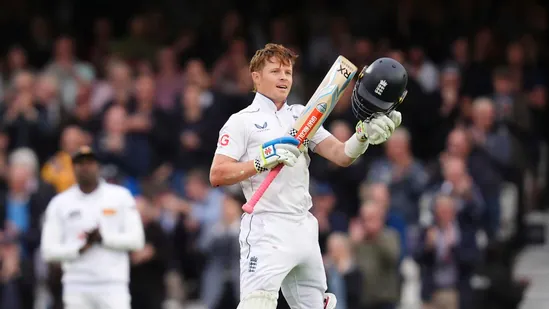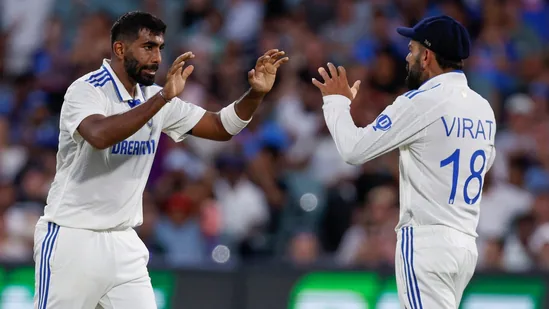Ashwin, the Maestro of his Trade, Engulfed in Flames, Gallops Towards a Majestic Dusk
As the wickets continued to fall during Australia's second innings at the Gabba on Wednesday, a palpable sense of anticipation spread through the media box. Whispers of a possible retirement from one of the modern greats of the game gained momentum, fueled by the poignant image of Virat Kohli embracing an emotional R Ashwin on television screens. The air was thick with speculation and emotion as fans and pundits alike braced themselves for a potential announcement that could change the face of cricket.

An hour or so later, the ace off-spinner accompanied his captain to the press conference. With Rohit Sharma seated to his right, Ashwin formally called it quits from international cricket, reiterating that he would continue to play club (franchise) cricket. It wasn’t quite the ultimate body blow, but it still was a bolt from the blue. Ashwin has been around for so long that he has almost been taken for granted, which is a backhanded compliment of sorts but also a tribute to his longevity, to the genius of his craft, to his constant endeavour to keep improving and becoming a better version of himself.
How will the cricket world remember Ashwin? A lion-hearted competitor, to start with. No situation fazed him, he didn’t believe anything was impossible. Sometimes, that worked against him, sure. When he was required to do a holding job, for instance, he often went looking for wickets because that’s what comes naturally to him. That thought process didn’t always align with the team’s requirements and there are certain to have been ideological differences with his captains, but those leaders also realised that Ashwin was coming from a good place and were from time to time willing to back his thinking when they found merit in that approach.
From being a top-order batter in his junior days – he played in the Under-17 Asia Cup, alongside Rohit, in that capacity in Bengaluru more than two decades back – to becoming India’s second most prolific wicket-taker has been a glorious journey of struggle and endeavour, of sweat and toil, of tireless zeal and unflagging commitment. His determination to keep bettering himself has been second to none. He has always been his biggest competitor, though he has looked outwards, picked the brains of people he has respected and held in high esteem, used the training ground as his laboratory and left no stone unturned in his remarkable desire to keep raising the bar.
Not the most naturally athletic, the fact that he played for the country for 14 and a half years, finished with 537 Test wickets and 765 scalps in all three formats internationally speaks to him keeping himself cricket-fit for so long. He didn’t miss too many games through injury, which is a huge tick in the box, whichever way you look at it. He had wonderful hands, was a safe catcher anywhere and a decent enough fielder in his younger days, though the passage of time meant he was a bit of a lumberer on the park in the last couple of years or so.
Biggest match-winnerWhile his exploits in Test cricket will be eulogised, and rightly so for he was the biggest match-winner for both Mahendra Singh Dhoni and Kohli, under whom he took an astonishing 283 wickets in 55 Tests, he was a key component in limited-overs set-ups too. A 50-over World Cup winner in 2011 when he was pretty much an understudy to Harbhajan Singh, he made a comeback to the World Cup squad last year too as an injury replacement for Axar Patel, though his appearance was reduced to one game, against Australia in Chennai. He was adept at bowling in the Powerplay and Dhoni in particular trusted him at the death too, not least in the final of the Champions Trophy in 2013 when, in a match reduced to 20 overs a side, he trusted his ace offie to defend 15 in the final over. Ashwin didn’t let his captain or his team down, conceding just nine to bowl India to a famous five-run triumph against England in Birmingham. That was India’s last ICC trophy until they won the T20 World Cup in Bridgetown this June.
Ashwin was the master of the carrom ball, the one delivered with a flicked right middle finger that defied convention and broke from leg to off to the right-handed batter. It was with one such ball that he accounted for Hashim Amla in the semifinal of the T20 World Cup in Mirpur in 2014. To many, it rivalled Shane Warne’s ball of the century to Mike Gatting in June 1993, in what was the legendary leggie’s first ball in a Test in England. Ashwin’s was perhaps even more electrifying because it was a finger-spinning slice of magic against a batter whose proficiency against spin was second to none. That ball didn’t exactly define Ashwin, but it symbolised him.
A fabulous timer of the cricket ball who was as effortless as VVS Laxman at his prime, Ashwin stacked up six Test centuries, including a flowing 113 against Bangladesh in Chennai just three months back. To sign off with more than 3,500 runs at an average of 25.75 is no mean accomplishment for a bowler with more than 530 Test wickets, though Ashwin will feel he should and could have done better. There hasn’t been a better spinning all-rounder in contemporary cricket, though Ravindra Jadeja will come a close second even though he has largely been forced to operate in the giant shadow of the engineer from Chennai.
Now 38, Ashwin won’t go away from cricket, not by a long way. He is too invested in the game to step away even when he finishes playing the sport. Rohit jokingly hinted that he would join ‘you guys’ – the media corps – in future. Already a social media star with a successful YouTube presence, his second innings will be every bit as colourful and successful as the first. Ashwin will make sure that’s the case, because he doesn’t like to settle for second best. Gladly or otherwise.
Stay informed with the...RELATED STORIES






LATEST NEWS







